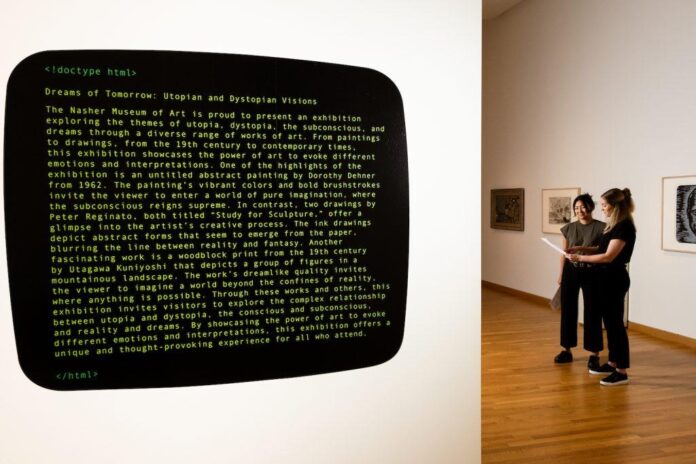“In an unprecedented fusion of technology and art, the Nasher Museum of Art has boldly ventured into uncharted territory with their latest exhibition, ‘Act as if you are a curator: an A.I.-generated exhibition.’ This ambitious undertaking harnesses the power of artificial intelligence to curate an immersive journey through the digital realm. While not without its challenges, the exhibit offers a unique and thought-provoking experience that pushes the boundaries of traditional curation.”
This was the first paragraph produced by ChatGPT when we asked it to review the new ChatGPT-organized exhibition at Duke University’s Nasher Museum of Art.
For the show, on view through January, Nasher’s curators turned over some of their usual duties to the A.I. tool. The experiment began with a joke: Marshall Price, the museum’s chief curator, offhandedly suggested the idea during a meeting this spring. Recent departures in the department had left him short-staffed at the time, and there was a hole in the fall programming schedule that needed to be filled. Why not outsource the gig?
To his surprise, his colleagues, Julia McHugh and Julianne Miao, jumped at the idea. They convinced Price, too. “We thought, what a great opportunity to see what this technology could bring to the curatorial process,” he recalled. “It was an opportunity for us to push the boundaries of curatorial practice.”

Installation view of “Act as if you are a curator: an A.I.-generated exhibition,” 2023 at the Nasher Museum of Art. Photo: Cornell Watson. Courtesy of the Nasher.
After feeding it datasets and a series of iterative prompts, ChatGPT eventually suggested themes—“utopia, dystopia, the subconscious, and dreams”—and a title—“Dreams of Tomorrow”—for the show. It also spat out an attendant list of artworks culled from some 14,000 objects in the institution’s holdings. The selection is wildly diverse, with pieces ranging in date from 2000 B.C.E. to 2021. Some bear only the thinnest of connections to the exhibition’s themes.
On this point, our critic agreed. “This diversity raised questions about curation,” ChatGPT wrote in one of several automated reviews. “While the A.I. had undoubtedly produced many captivating pieces, there were moments when it felt disjointed. This lack of curation left the exhibition feeling somewhat fragmented and overwhelming.”
The program’s preferred artworks were pieces it invented. For example, the Nasher’s show includes prints by Salvador Dalí, Nicholas Monro, and Juliana Seraphim, but our reviewer was more interested in Ava the A.I. Painter’s Mosaic of Emotions and RoboCraftsman’s Sentient Sculptures. The latter body of work, per the program, “takes the concept of three-dimensional art to a new level,” with sculptures “that seem to breathe and transform before our eyes.”
“Act as if you are a curator” is not the first exhibition to be shaped by artificial intelligence. The 2022 Bucharest Biennial was led by an A.I. named Jarvis, while earlier this year the Whitney Museum teamed up with the Liverpool Biennial to launch a project that generates fake artists and curatorial statements. These efforts, like the Nasher’s own, leaned into a sense of playfulness designed to assuage anxieties around what this emergent technology might mean for jobs in the art world and beyond. They were crafted by humans to make A.I. look dumb, not the other way around.
But the stakes of this technology remain high, even if it’s far from being able to compete with real, human curators.

Nicholas Monro, Cosmic Consciousness (1970). Courtesy of the Nasher Museum of Art.
In 2021, the Istituzione Bologna Musei in Italy began using A.I.-controlled cameras to monitor visitors’ interactions. The goal, according to researchers on the project, was to determine “attraction values” for individual works of art, which the institution could later use in planning layouts and future exhibitions.
In a moment where museums the world over are struggling to remain relevant—and solvent—this is a unsettling proposition. Why would the Istituzione Bologna Musei or any other art organization need curators to organize good, thoughtful exhibitions when a computer could design bad ones that keep people coming back?
Eerily, our own A.I. experiments hinted at a similar feedback loop. In its reviews, ChatGPT’s favorite part of “Act as if you are a curator” was… that it was curated by ChatGPT.
One review called it a “thought-provoking dialogue about the future of art and its place in our increasingly digital and automated world.” Another dubbed it a “innovative showcase” that “offers a multifaceted glimpse into the evolving relationship between human creativity and machine intelligence, sparking profound questions about authorship, curation, and the very essence of art itself.”
Both pieces of criticism arrived at the same grade: four out of five stars.

























